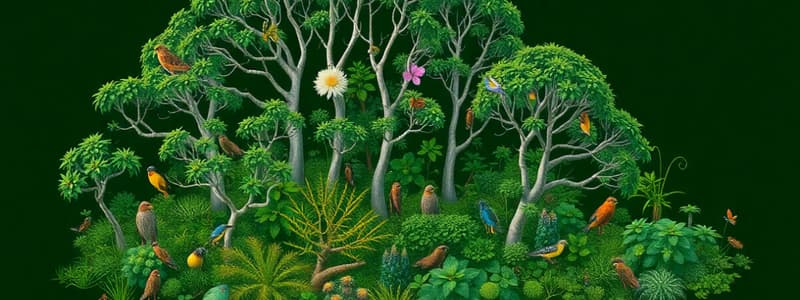Podcast
Questions and Answers
What does 'abundance' refer to in the context of community structure?
What does 'abundance' refer to in the context of community structure?
- The variety of species in an area
- The spatial arrangement of individuals
- The health and size of individuals in an area
- The number of individuals of the same species in an area (correct)
Which of the following describes 'species diversity'?
Which of the following describes 'species diversity'?
- The number of different species present (correct)
- The spatial arrangement of a single species
- The total number of individuals in a population
- The evenness of individuals in a population
What aspect of community structure does 'distribution' describe?
What aspect of community structure does 'distribution' describe?
- The types of species present
- How many individuals there are
- The genetic relationships between individuals
- Where individuals are located in space (correct)
What does standard deviation indicate when only one average is presented?
What does standard deviation indicate when only one average is presented?
Considering components of community structure, what information does knowing the abundance provide?
Considering components of community structure, what information does knowing the abundance provide?
In Figure 1, what two locations are being compared regarding the capture of clams?
In Figure 1, what two locations are being compared regarding the capture of clams?
Which component of community structure considers both the number of different species and their location?
Which component of community structure considers both the number of different species and their location?
According to Figure 1, approximately how many clams were captured in Lewes, DE?
According to Figure 1, approximately how many clams were captured in Lewes, DE?
According to Figure 1, approximately how many clams were captured in Wilmington, DE?
According to Figure 1, approximately how many clams were captured in Wilmington, DE?
What type of variation does Figure 1 help to show about clam capture?
What type of variation does Figure 1 help to show about clam capture?
What does the 'range' refer to in the context of environmental studies?
What does the 'range' refer to in the context of environmental studies?
Within environmental studies, what does 'standard deviation' indicate?
Within environmental studies, what does 'standard deviation' indicate?
In the study of organisms and their environment, 'variation' implies that environmental factors are:
In the study of organisms and their environment, 'variation' implies that environmental factors are:
Which of the following is an example of an environmental factor that commonly varies?
Which of the following is an example of an environmental factor that commonly varies?
Which of the following concepts is associated with describing the quantity of an environmental variable?
Which of the following concepts is associated with describing the quantity of an environmental variable?
What constitutes a community in ecology?
What constitutes a community in ecology?
Which of the following defines a population?
Which of the following defines a population?
What is the primary focus when studying community structure?
What is the primary focus when studying community structure?
What is spatial variation in the context of communities?
What is spatial variation in the context of communities?
Which of the following is most likely to influence the structure of a community?
Which of the following is most likely to influence the structure of a community?
What does quantitative variation primarily focus on?
What does quantitative variation primarily focus on?
Which statistical measure is used to describe the spread of data in quantitative variation?
Which statistical measure is used to describe the spread of data in quantitative variation?
What is the main focus of temporal factors in qualitative variation?
What is the main focus of temporal factors in qualitative variation?
Which concept does 'range' describe in the context of quantitative variation?
Which concept does 'range' describe in the context of quantitative variation?
What aspect of the environment do spatial factors in qualitative variation relate to?
What aspect of the environment do spatial factors in qualitative variation relate to?
Flashcards
Average in Graphs
Average in Graphs
The central value that summarizes a set of data points.
Standard Deviation
Standard Deviation
A measure of the amount of variation or dispersion in a set of values.
Temporal Variation
Temporal Variation
Change in data across different time periods.
Spatial Variation
Spatial Variation
Signup and view all the flashcards
Bar Graph Analysis
Bar Graph Analysis
Signup and view all the flashcards
Abundance
Abundance
Signup and view all the flashcards
Species Diversity
Species Diversity
Signup and view all the flashcards
Distribution
Distribution
Signup and view all the flashcards
Community Structure
Community Structure
Signup and view all the flashcards
Ecological Components
Ecological Components
Signup and view all the flashcards
Variation
Variation
Signup and view all the flashcards
Quantity of Variation
Quantity of Variation
Signup and view all the flashcards
Range
Range
Signup and view all the flashcards
Non-Constant Variation
Non-Constant Variation
Signup and view all the flashcards
Quantitative Variation
Quantitative Variation
Signup and view all the flashcards
Qualitative Variation
Qualitative Variation
Signup and view all the flashcards
Temporal Factors
Temporal Factors
Signup and view all the flashcards
Community
Community
Signup and view all the flashcards
Population
Population
Signup and view all the flashcards
Species
Species
Signup and view all the flashcards
Interactions
Interactions
Signup and view all the flashcards
Study Notes
Components of Community Structure
- Abundance: the number of individuals of the same species in a given area
- Species Diversity: the number of different kinds of organisms (species) also considers which species are present
- Distribution: where individuals are in space.
Studying That Suits You
Use AI to generate personalized quizzes and flashcards to suit your learning preferences.




